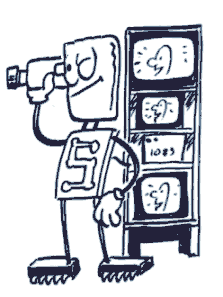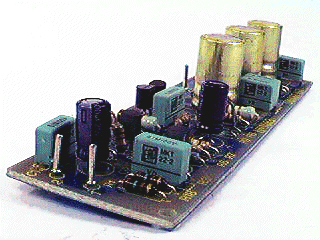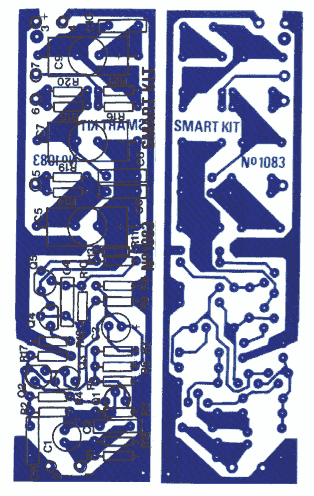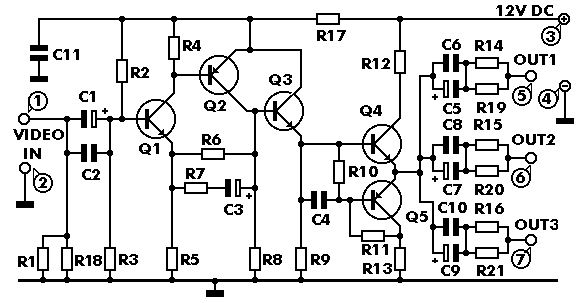Video Signal Amplifier
General Description
Video cassette recorders are becoming ever so popular and as it was to be expected
the market is flooding with accessories that make the use of the VCR easier and
enhance its operation. The circuit that we offer to you here is a broad band amplifier
which will take the video signals from your VCR and will amplify them sufficiently
to drive up to 3 monitors, TV sets (provided that they can accept direct video signals),
or other VCR�s for recording from one video to up to three others. It will also
make possible to record from one video to two others and at the same time have a
monitor connected to check what you are recording. The amplifier is also very useful
if the video recorder is far from the monitor.

How it Works
The circuit uses five transistors and is a broad band amplifier with a bandwidth
of 5 MHz. The signal is applied at points 1 and 2 (ground) and is taken through
C1 to the first stage which is a preamplifier and is built around Q1. In the output
of Q1 are DC coupled Q2,3 which amplify the signal more, and as they are DC coupled
to the preamplifier there is virtually no distortion and the amplification is quite
high. Finally the signal from the out put Q3 is fed to the output transistors which
are Q4 & Q5. These two transistors are complementary and the signal from their common
emitters is taken to the signal distribution R-C network from where it is sent to
the various devices which are driven by the circuit. The circuit needs a 12 VDC
power supply and it is much better if it is a stabilised one like the circuit printed
elsewhere in the instructions.

Construction
First of all let us consider a few basics in building electronic circuits on a printed
circuit board. The board is made of a thin insulating material clad with a thin
layer of conductive copper that is shaped in such a way as to form the necessary
conductors between the various components of the circuit. The use of a properly
designed printed circuit board is very desirable as it speeds construction up considerably
and reduces the possibility of making errors. Smart Kit boards also come pre-drilled
and with the outline of the components and their identification printed on the component
side to make construction easier. To protect the board during storage from oxidation
and assure it gets to you in perfect condition the copper is tinned during manufacturing
and covered with a special varnish that protects it from getting oxidised and also
makes soldering easier. Soldering the components to the board is the only way to
build your circuit and from the way you do it depends greatly your success or failure.
This work is not very difficult and if you stick to a few rules you should have
no problems. The soldering iron that you use must be light and its power should
not exceed the 25 Watts. The tip should be fine and must be kept clean at all times.
For this purpose come very handy specially made sponges that are kept wet and from
time to time you can wipe the hot tip on them to remove all the residues that tend
to accumulate on it. DO NOT file or sandpaper a dirty or worn out tip. If
the tip cannot be cleaned, replace it. There are many different types of solder
in the market and you should choose a good quality one that contains the necessary
flux in its core, to assure a perfect joint every
time.

DO NOT use soldering flux apart from that which is already included in your solder.
Too much flux can cause many problems and is one of the main causes of circuit malfunction.
If nevertheless you have to use extra flux, as it is the case when you have to tin
copper wires, clean it very thoroughly after you finish your work. In order to solder
a component correctly you should do the following:
- Clean the component leads with a small piece of emery paper.
- Bend them at the correct distance from the component�s body and insert the component
in its place on the board.
- You may find sometimes a component with heavier gauge leads than usual, that are
too thick to enter in the holes of the p.c. board. In this case use a mini drill
to enlarge the holes slightly. Do not make the holes too large as this is going
to make soldering difficult afterwards.
- Take the hot iron and place its tip on the component lead while holding the end
of the solder wire at the point where the lead emerges from the board. The iron
tip must touch the lead slightly above the p.c. board.
- When the solder starts to melt and flow, wait till it covers evenly the area around
the hole and the flux boils and gets out from underneath the solder. The whole operation
should not take more than 5 seconds. Remove the iron and leave the solder to cool
naturally without blowing on it or moving the component. If everything was done
properly the surface of the joint must have a bright metallic finish and its edges
should be smoothly ended on the component lead and the board track. If the solder
looks dull, cracked, or has the shape of a blob then you have made a dry joint and
you should remove the solder (with a pump, or a solder wick) and redo it.
- Take care not to overheat the tracks as it is very easy to lift them from the
board and break them.
- When you are soldering a sensitive component it is good practice to hold the lead
from the component side of the board with a pair
of long-nose pliers to divert any heat that could possibly damage the component.
- Make sure that you do not use more solder than it is necessary as you are running
the risk of short-circuiting adjacent tracks on
the board, especially if they are very close together.
- When you finish your work cut off the excess of the component leads and clean
the board thoroughly with a suitable solvent to
remove all flux residues that may still remain on it.
- The construction should not present any difficulties if you follow the circuit
diagram carefully and place the components in their place as it is outlined on the
component side of the p.c. board. Solder first of all the pins, then the resistors,
the capacitors making sure that the electrolytic are connected correctly with respect
to their polarity and finally insert the transistors in their places and solder
them very carefully as overheating during soldering can destroy them. When all the
components have been soldered make a careful inspection of the circuit and if you
are satisfied that there are no mistakes make the following connections:
- Supply voltage at points 3 (+12 VDC) and 4 (-).
- Input signal at points 1 (signal) and 2 (common).
- Outputs 5,6,7 (signal) and 4 (common).
As it is only two of the outputs are connected initially. To enable the third you
should also connect the positive leads of C7 and C9 together.


Title: Video Signal Amplifier
electronic circuit
Source: smartkit
Published on: 2005-06-19
Reads: 2832
Print version: ![]()
Other electronic circuits and schematics from Video and TV
-
S-video to composite video adapter
-
Audio / video switch
-
Video/Audio Wireless Transmitter
-
Composite color video signal travels on twisted-pair cable
-
Isolation between antenna network and TV/radio equipment
-
Video Distributor Amplifier
-
Video Line Selector
-
Video Clock and Message Generator
-
Video Switch
-
UHF Preamplifier
